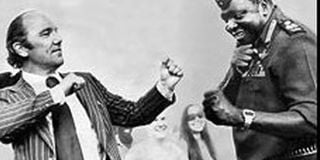How many people did Amin really kill?

Idi Amin shares a light moment with Ian Wooldrige, a British sports journalist. PHOTO BY AGENCIES
What you need to know:
Footprints of death: Idi Amin used State organs and groups to eliminate his opponents or just unleashed terror on the population, as he sought to tighten his grip onto power.
It is widely known that Idi Amin caused the killing and disappearance of scores of people during his eight-year rule in Uganda. The uncertainty however remains in the actual number of people slain by the country’s third president.
The International Commission of Jurists in Geneva estimate the number of people killed by Amin at between 80,000 and 300,000. Another estimate by exile organisations and Amnesty International, put the number of people killed at 500,000 out of the 12 million Ugandans at the time.
Although it’s difficult to ascertain the actual number of people slain by Amin, what is clear is the legacy of bloodthirsty killings and economic bungling that has continued to persevere in varying magnitude.
Tracing Amin’s extermination schemes, historian Samwiri Karugire writes that when the Field Marshal took over power from Obote, he embarked on the elimination of his opponents “real or imaginary”. The Langi and Acholi army officers, whom Obote had relied on to embed his presidency, became the early victims of Amin’s wrath.
However, even though the killings started a few months after the 1971 coup, Karugire says Ugandans did not give it the due concern, an attitude that could have silently tolerated the murders.
“…because Ugandan societies were so deeply differentiated, these early ‘tribal’ murders did not appear alarming,” explains Karugire in his book, Roots of Instability in Uganda.
Karugire cites Amin’s Public Safety Unit, the State Research Bureau and the Defence Council, as organs used to carry out a myriad of killings.
“These were the principal organs which were responsible for kidnapping and liquidation of countless Ugandans…their informers were to be found everywhere as their license to kill, maim, detain or extort was not subject to any restraint.”
Phares Mutibwa, the author of Uganda since Independence, describes the exterminations during Amin’s first 20 months in office as massacres, citing the July 1971 attempted coup on Amin, where “…Acholi and Langi soldiers were massacred at Jinja, Moroto and Mbarara barracks”. The other mass killings, according to Mutibwa, were at Mutukula on the Uganda- Tanzania border in February 1972, the attempted coup in June 1972 and the September 1972 invasion.
The killings which took place away from the city and free from cameras, would, despite reporting by journalists Nicholas Stroh and Siedle, not be believed by locals or foreigners, Mutibwa explains.
“Foreigners as well as Ugandans tended to see the killings as no more than the normal ‘mopping up operations’ that follow a coup. But the murders of the military officers and men were never reported, nor were they believed by Western diplomats based in Kampala, the British and Israelis openly ridiculing suggestions of mass killings.”
However, in Tanzania, Julius Nyerere, who offered refuge to Obote, insisted that his ousted colleague was the legitimate president of Uganda, while Amin was a murderer.
“How can I sit at the same table with a killer? Jomo (Kenyatta) is speaking for his people who elected him. I am speaking for you. Whom will Amin be representing? I cannot sit with murderers,” Nyerere, addressing a rally in Dar es Salaam, says as quoted in General Amin by David Martin.
By 1973, Amin had removed the thin gloves of civility or mask he had been wearing as his actions became visible and attracted condemnation on the international scene, including his cronies Britain and the Israelis.
“By the beginning of 1973, Amin’s true nature was emerging –what Grace Ibingira has described as a combination of guile, buffoonery and utter ruthlessness in killing anyone even remotely suspected by him or his subordinates of being unfriendly. The marriage between Amin and the population had not yet collapsed; no one was talking of divorce, but certainly the honeymoon was over,” elaborates Mutibwa.
The killings cut across all sections of the population; the army, ordinary civilians, farmers, students, clerks, shopkeepers, government officials, imagined or real political opponents as well as religious figures, notably Janani Luwum, the Archbishop of the Church of Uganda. These victims were, according to historical accounts, shot or forced to club one another to death by the ‘death squads’.
Two thirds of soldiers, out of a total of 9,000 men, appeared to have been executed in Amin’s first year of power, according to accounts.
By the time Amin was toppled in 1979, the smell of death and fright hung over Uganda.
Despite the uncertainty about the number of people killed during the regime, the events that transpired between February 2, 1971 and April 11, 1979, will remain inked in Uganda’s history due to its blood-stained character and overbearing administration.
Continues Monday.




